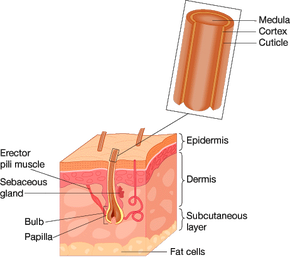What Exactly Is Hair?
Typical mammalian hair consists of the shaft, protruding above the skin, and the root, which is sunk in a follicle, or pit, beneath the skin surface. Except for a few growing cells at the base of the root, the hair is dead tissue and is composed of keratin and related proteins. The hair follicle is a tubelike pocket of the epidermis, (see How Skin Works) that encloses a small section of the dermis at its base. Human hair is formed by rapid divisions of cells at the base of the follicle. As the cells are pushed upward from the follicle's base, they harden and undergo pigmentation.
The hair on our scalps and in our eyebrows and eyelashes are different from other bodily hairs. The hair on our heads grows a healthy .5 inch per month, and long scalp hairs have an average life of 3 to 5 years. Most of us have between 100,000 and 150,000 hairs on our heads!
Advertisement
There are two kinds of melanin found in the hair: eumelanin (the most common and responsible for hair shades from brown to black) and phaeomelanin (responsible for yellowish-blond, ginger and red colors). Absence of pigment produces white/gray hair. Before any permanent color can be deposited into the hair shaft, the cuticle, or outer layer, must be opened. The insoluble formula then reacts with the cortex to deposit or remove the color.
